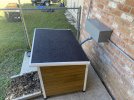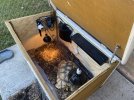Jmeyer
New Member
Hi. So I have a 3 year old sulcata named Pat. He is currently about 35lbs. I live in Louisiana and during the winter temperatures can drop to low 40s or high 30s. (They can go lower but if they did I would bring him inside). This is his first year being a full time outdoor tortoise. He has the entire backyard available to roam and I modified a doghouse for him to sleep in and be warm. The doghouse has a a powered doghouse heater, a basking halogen bulb, a CHE, and a uvb light for kicks. Everything is time or temp controlled. I also made a double wall with insulation. My question…
Last night outside temp dropped to 45 degrees. Inside his house stayed above 60 most of the night but did drop to 55 for an hour or so. Not bad but I did have an extra flap down in front of the door which I would rather leave up to make it easier for him to come and go. I am about to leave for over a week and the temperatures are expected to get even colder. And even be cold and rainy during the day. What nighttime temps can a tortoise of his size be expected to tolerate and for how long? Should I have any concerns? And any suggestions on ways to increase warmth in the house?
Last night outside temp dropped to 45 degrees. Inside his house stayed above 60 most of the night but did drop to 55 for an hour or so. Not bad but I did have an extra flap down in front of the door which I would rather leave up to make it easier for him to come and go. I am about to leave for over a week and the temperatures are expected to get even colder. And even be cold and rainy during the day. What nighttime temps can a tortoise of his size be expected to tolerate and for how long? Should I have any concerns? And any suggestions on ways to increase warmth in the house?





